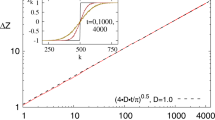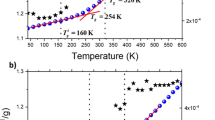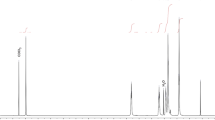Abstract
ENTANGLEMENTS, their nature and their role in the dynamic properties of concentrated polymer solutions and melts are not well understood1,2. The classical molecular view of entanglements has been one of rope-like intermolecular couplings at a number of points along the length of a molecule; molecules in motion would drag past these couplings, the essential effect being one of enhanced friction1,3. There has been a growing realisation that this model is inadequate2,4,5. The essence of the problem, rather, seems to be that of the topological restrictions imposed on the motion of each polymer molecule by its neighbours: movement of a given polymer chain is constrained at the points of entanglement or intersection with adjacent chains2. Theoretical treatment of the topological problem is difficult6, and has met only with limited success5. An interesting proposal regarding the motion of molecules within entangled polymer systems has been put forward by De Gennes4,7: according to this, the motion of a given polymer molecule is confined within a virtual ‘tube’ defined by the locus of its intersections (or points of ‘entanglement’) with adjacent molecules (Fig. 1). The molecule is constrained to wriggle, snake-like, along its own length, by curvilinear propagation of length defects such as kinks or ‘twists’8 along the tube; this mode of motion has been termed reptation4 (from reptile). Reptative motion clearly satisfies the central requirement of entangled systems: that of the non-crossability by a given chain of the contours of its adjacent neighbours. In a real polymer melt the topological environment of any given molecule (that is, the virtual ‘tube’ surrounding it) will itself change with time. This is because the adjacent molecules defining it are themselves mobile. If this reorganisation is sufficiently slow then the translational motion of the enclosed molecule will be effectively curvilinear (reptative). Consideration of the problem9 suggests that this will be the case in an entangled system. One then expects translational diffusion to be dominated by reptation. There is no direct experimental evidence supporting the physical reality of curvilinear motion in entangled polymer systems. I report here the results of experiments on diffusion within a polyethylene melt critically designed to test the reptation concept.
This is a preview of subscription content, access via your institution
Access options
Subscribe to this journal
Receive 51 print issues and online access
$199.00 per year
only $3.90 per issue
Buy this article
- Purchase on Springer Link
- Instant access to full article PDF
Prices may be subject to local taxes which are calculated during checkout
Similar content being viewed by others
References
Ferry, J. D. Viscoelastic Properties of Polymers 2nd edn (Wiley, London, 1970).
Graessley, W. W. Adv. pol Sci. 16, 1–179 (1974).
Bueche, F. J. chem. Phys. 20, 1959–1964 (1952); Physical Properties of Polymers (Interscience, London, 1962).
De Gennes, P. G. J. chem. Phys. 55, 572–579 (1971).
Edwards, S. F. & Grant, J. W. V. J. Phys. A6, 1169–1185 (1973).
Edwards, S. F. Proc. phys. Soc. 91, 513–519 (1967).
De Gennes, P. G. Macromolecules 9, 587–598 (1976).
Reneker, D. H. & Fanconi, B. J. appl. Phys. 46, 4144–4147 (1975).
Klein, J. Macromolecules (submitted).
McCall, D. W., Douglass, D. C. & Anderson, E. W. J. chem. Phys. 30, 771–773 (1959); J. pol. Sci. A1, 1709–1720 (1963).
McCall, D. W. & Huggins, C. M. Appl. Phys. Lett. 7, 153–154 (1965).
Tanner, J. E., Lui, K.-J. & Anderson, J. E. Macromolecules 4, 586–588 (1971).
Tanner, J. E. Macromolecules 4, 748 (1971).
Cosgrove, T. & Warren, R. F. Polymer 18, 255–258 (1977).
Bueche, F., Cashin, W. & Debye, P. J. chem. Phys, 20, 1956–1959 (1952).
Skewis, J. D. Rubb. Chem. Technol. 39, 217–225 (1966).
Bueche, F. J. chem. Phys. 48, 1410–1411 (1968).
Lieser, G., Fischer, E. W. & Ibel, K. J. Pol. Sci. Pol. Lett. 13, 39–43 (1975).
Schelten, J., Ballard, D. G. H., Wignall, G. D., Longman, G. & Schmatz, W. Polymer 17, 751–757 (1976).
Klein, J. & Briscoe, B. J. Nature 257, 386–7 (1975); Polymer 17, 481–484 (1976).
Crank, J. Mathematics of Diffusion 2nd edn (Oxford University Press, London, 1975).
Author information
Authors and Affiliations
Rights and permissions
About this article
Cite this article
KLEIN, J. Evidence for reptation in an entangled polymer melt. Nature 271, 143–145 (1978). https://doi.org/10.1038/271143a0
Received:
Accepted:
Issue Date:
DOI: https://doi.org/10.1038/271143a0
This article is cited by
-
Self-healing polymers
Nature Reviews Materials (2020)
-
Entangled polymer dynamics beyond reptation
Nature Communications (2018)
-
Rheological modeling of the diffusion process and the interphase of symmetrical bilayers based on PVDF and PMMA with varying molecular weights
Rheologica Acta (2012)
-
Analytic derivation of the Cox–Merz rule using the MLD “toy” model for polydisperse linear polymers
Rheologica Acta (2011)
-
Modes of energy loss on shearing of thin confined films
Tribology Letters (2007)
Comments
By submitting a comment you agree to abide by our Terms and Community Guidelines. If you find something abusive or that does not comply with our terms or guidelines please flag it as inappropriate.



